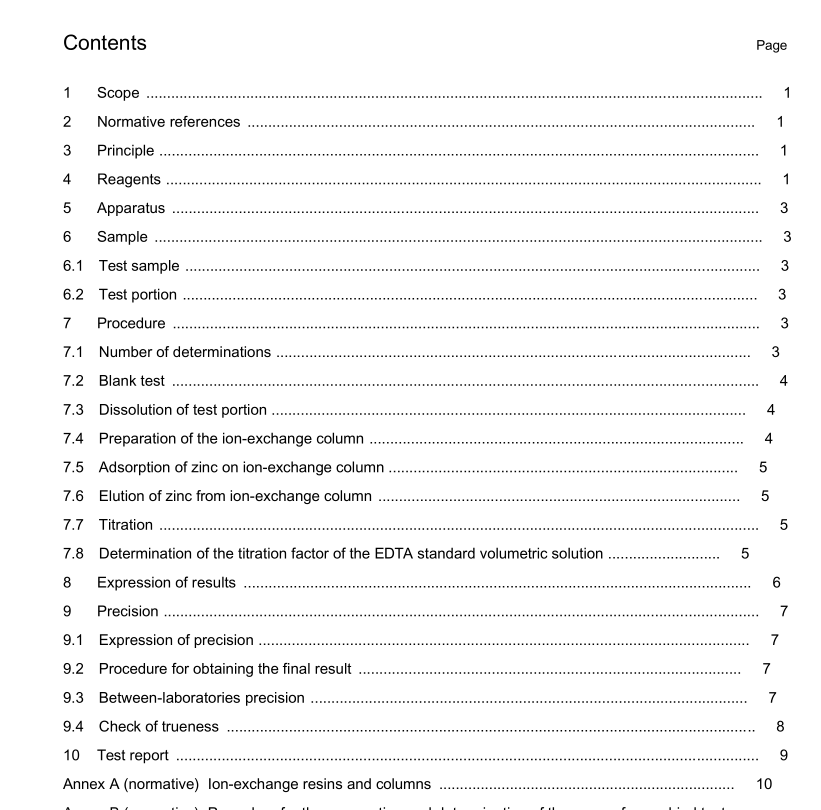BS ISO 12739 pdf download

BS ISO 12739 pdf download Zinc sulfide concentrates — Determination of zinc — Ion-exchange/EDTA titrimetric method
7.2 Blank test Determine a reagent blank.
It is advisable to perform duplicate blank determinations every time an analysis is carried out on a laboratory sample. The blank samples are carried through the whole procedure, apart from where no laboratory sample test portion is required. The volume of EDTA titrant used is V b .
7.3 Dissolution of test portion Place the test portion in a 300 ml conical beaker. Add 25 ml of hydrochloric acid (4.3). Cover with a watch glass and heat the beaker and contents gently for 5 min. Add 20 ml of dilute nitric acid (4.7) and 15 ml of dilute sulfuric acid (4.8). Heat and evaporate the solution to about 5 ml. Cool and add, with caution, about 50 ml of water and boil the solution. Cool the solution to room temperature and filter it into a 300 ml beaker through a medium-speed cellulose filter paper. Wash the beaker and filter paper thoroughly with dilute sulfuric acid (4.9), collecting the washings in the same beaker.
If an acid-insoluble material is present, place the filter and insoluble residue in a platinum crucible (5.5) (see the last five paragraphs of this subclause) and gently reduce the paper to ashes in the muffle furnace (5.4) at 800 ◦ C 2 ml 2 ml .
Allow the crucible and residue to cool to ambient temperature. Add of dilute sulfuric acid (4.8), of nitric acid (4.6) and 2 ml of hydrofluoric acid (4.10) and evaporate the solution nearly to dryness. Cool and add water in small quantities to dissolve the soluble salts. Filter through a medium-speed cellulose filter paper and add the filtrate and washing solution to the initial solution obtained above as described in paragraphs 1 to 3. Heat to evaporate the combined filtrates to a volume of 60 ml to 80 ml. Cool and add 16 ml of hydrochloric acid (4.3). Dilute to 100 ml with water. If the sample contains lead, damage to the platinum crucible may occur.
In this case, acid-insoluble material should be treated as follows. Rinse the insoluble residues into a polytetrafluoroethylene beaker with a fine jet of water. Place the filter in a porcelain crucible and gently ash the paper in the muffle furnace at 600 ◦ C to 700 ◦ C. Allow the crucible to cool to ambient temperature. Rinse the material from the crucible by washing with a small quantity of water into the polytetrafluoroethylene beaker used above.
Add 2 ml of dilute sulfuric acid (4.8), 2 ml of nitric acid (4.6) and 2 ml of hydrofluoric acid (4.10), and evaporate the solution nearly to dryness. Cool and add water in small quantities to dissolve the soluble salts. Filter through a medium-speed cellulose filter paper and add the filtrate and washing solution to the initial solution obtained above. Should it be confirmed that the filter paper contains no zinc, the procedure of ashing the filter paper may be omitted.
7.4 Preparation of the ion-exchange column Examples of ion-exchange columns that are suitable for use are shown in Annex A. Pack water-soaked cotton or glass-wool pads into the bottom of the column to a thickness of about 5 mm.
This will retain resin in the column during use. Soak the resin overnight in distilled water to make a slurry. With the stopcock open, carefully transfer the slurry into the column to form a settled bed.
This resin bed is formed by about 16 ml of the swollen resin. Close the stopcock and put about a 5 mm thickness of water-soaked glass wool or cotton wool on top of the resin. It is essential to ensure that the resin is covered by liquid at all times, because air trapped in a resin causes “channelling”, i.e. uneven flow rate and poor efficiency in the ion exchanger. If air enters the resin bed, it is recommended that the column be emptied and then repacked.









